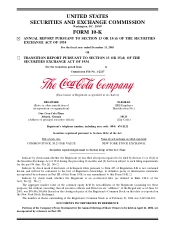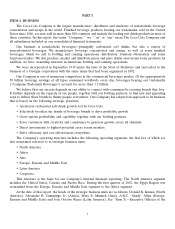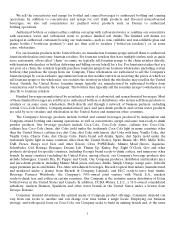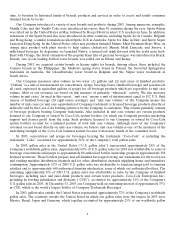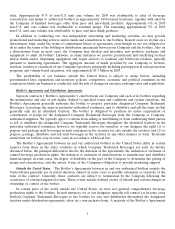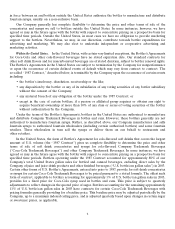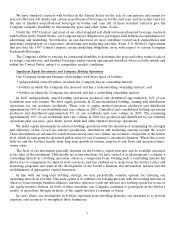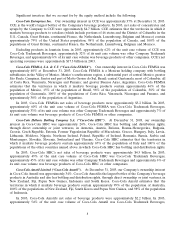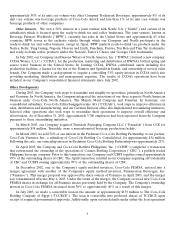Coca Cola 2003 Annual Report Download - page 7
Download and view the complete annual report
Please find page 7 of the 2003 Coca Cola annual report below. You can navigate through the pages in the report by either clicking on the pages listed below, or by using the keyword search tool below to find specific information within the annual report.time, to broaden its historical family of brands, products and services in order to create and satisfy consumer
demand locale by locale.
Our Company introduced a variety of new brands and products during 2003. Among numerous examples,
Vanilla Coke and diet Vanilla Coke were introduced into more than 50 countries during the year. Sprite Remix
was rolled out in the United States in May, followed by Barq’s Floatz in select U.S. markets in June. In addition,
extensions of the Sprite brand also were introduced in other countries, including Sprite Ice in Canada, Belgium
and Hong Kong; a similar formulation called Sprite ICE in Australia; Sprite Ice Blue in Italy; and Sprite Super
Lemon in Hong Kong. In the United States, other new products included Minute Maid Premium Heart Wise, an
orange juice product with plant sterols to help reduce cholesterol; Minute Maid Limeade; and Swerve, a
milk-based beverage. In Argentina, we launched Nativa, a natural soft drink flavored with the yerba mate herb.
Kuat with Orange, the latest extension of the popular Kuat line of guaran´
a beverages, was introduced in Brazil.
Dasani, one of our leading bottled water brands, was rolled out in Ghana and Kenya.
During 2003, we acquired certain brands or license rights for brands. Among others, these included the
Cosmos brands in the Philippines, the Multivita spring water brand in Poland, the Neverfail Springwater
trademark in Australia, the Chaudfontaine water brand in Belgium and the Valpre water trademark in
South Africa.
Our Company measures sales volume in two ways: (1) gallons and (2) unit cases of finished products.
‘‘Gallons’’ is a unit of measurement for concentrates, syrups, beverage bases, finished beverages and powders (in
all cases, expressed in equivalent gallons of syrup) for all beverage products which are reportable as unit case
volume. Most of our revenues are based on this measure of primarily ‘‘wholesale’’ activity. We also measure
volume in unit cases. As used in this report, ‘‘unit case’’ means a unit of measurement equal to 192 U.S. fluid
ounces of finished beverage (24 eight-ounce servings); and ‘‘unit case volume’’ of the Company means the
number of unit cases (or unit case equivalents) of Company trademark or licensed beverage products directly or
indirectly sold by the Coca-Cola bottling system or by the Company to customers. This volume primarily consists
of beverage products bearing Company trademarks. Also included in unit case volume are certain products
licensed to our Company or owned by Coca-Cola system bottlers, for which our Company provides marketing
support and derives profit from the sales. Such products licensed to our Company or owned by Coca-Cola
system bottlers account for a minimal portion of total unit case volume. Although most of our Company’s
revenues are not based directly on unit case volume, we believe unit case volume is one of the measures of the
underlying strength of the Coca-Cola business system because it measures trends at the consumer level.
In 2003, concentrates and syrups for beverages bearing the trademark ‘‘Coca-Cola’’ or including the
trademark ‘‘Coke’’ accounted for approximately 56% of the Company’s total gallon sales.
In 2003, gallon sales in the United States (‘‘U.S. gallon sales’’) represented approximately 28% of the
Company’s worldwide gallon sales. Approximately 60% of U.S. gallon sales for 2003 was attributable to sales of
beverage concentrates and syrups to approximately 80 authorized bottler ownership groups in approximately 394
licensed territories. Those bottlers prepare and sell finished beverages bearing our trademarks for the food store
and vending machine distribution channels and for other distribution channels supplying home and immediate
consumption. Approximately 32% of 2003 U.S. gallon sales was attributable to fountain syrups sold to fountain
retailers and to approximately 640 authorized fountain wholesalers, some of which are authorized bottlers. The
remaining approximately 8% of 2003 U.S. gallon sales was attributable to sales by the Company of finished
beverages, including juice and juice-drink products and certain water products. Coca-Cola Enterprises Inc.,
including its bottling subsidiaries and divisions (‘‘CCE’’), accounted for approximately 51% of the Company’s
U.S. gallon sales in 2003. At December 31, 2003, our Company held an ownership interest of approximately 37%
in CCE, which is the world’s largest bottler of Company Trademark Beverages.
In 2003, gallon sales outside the United States represented approximately 72% of the Company’s worldwide
gallon sales. The countries outside the United States in which our gallon sales were the largest in 2003 were
Mexico, Brazil, Japan and Germany, which together accounted for approximately 25% of our worldwide gallon
4

